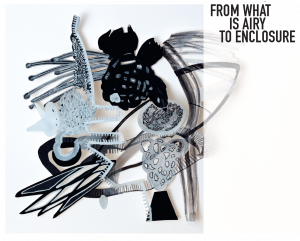FROM WHAT IS AIRY TO ENCLOSURE
 It is important to pinpoint decided antinomies, as many knotted articulations, that are only revealed after a first effect of ambulatory charm, baring the work of of its tensions.
It is important to pinpoint decided antinomies, as many knotted articulations, that are only revealed after a first effect of ambulatory charm, baring the work of of its tensions.
One of the first paradoxes of J. Jouannais’s work resides in the exchange she fosters between mass and lightness. Being works made of paper, a type of lace painting, lighting the density of a wall, attracting them by opposite magnetism; suspended cutouts suggesting a spatial volume that the eye can visit; or ceramic micro organisms oscillating between texture excitement and the imaginative side of an architecture model; the material concreteness and the work’s mass always seem staged, almost choreographed. I am thinking for example of the patched up effects in cracks or brittlenesses, that are never concealed. I also spot the vivacity of some gone off track indentations of which the darns are not erased. Or again, of course, all the vocabulary of straps, ropes, support clips, platform-plinths, that is present as a reminder of the materiality of the work, of its necessary conjugation to gravity.
And however, in the same impulse, stubborn in their will to systematically upset the masses, processes of reduction leading sometimes as far as the membrane or thescreenproduce an effect of dematerialisation by transforming the viewer in a virtual visitor. In that respect, between fall and elevation a tension arises, playing with compressions and dilatations, choreographing the scansions between desertion and rigidity, obliging the visitor to constantly renegociate the virtual trajectory that is drawn in his imaginary landscape.
This ambivalence between collapse and takeoff calls another, being of the conjugation between interiority and exteriority. Following our dreamlike deambulation between macroscopic and microscopic, an organic vocabulary unfolds in a game of openwork membranes, ofscreened epidermis. But, equally, the sharp ridges induce a type of exoskeleton that would have been excavated of its organic spinelessness. From hard to soft, from membrane to structure, from skin to bone, the works of J. Jouannais are as many ambiguous skinned alive organisms, of which one no longer knows if they fray or wrap. Indeed, bone and skin, surface and structure hybridise in a game of two-sided lamé, that always enables the work to exist on both sides. From inside to outside, from parade to nakedness, again our eye hesitates and travels in uncertainty. There is, in this three dimensional dance, an energy that forces the viewer’s gaze to conceive a subjective world where fall and rise are simultaneously conjugated on the surface and in depth. The floating blades, coloured on both sidesact out the strategy of Baroque folds : points of articulation between the vertical dynamic of gravity and takeoff, and of, in depth,weft and intimacy. In that respect one finds in the work of J. Jouannais something being of a grammar of facade and monad, as observed in the aesthetic of the Baroque fold by Gilles Deleuze. Where facade presents a pure verticalized exteriority that may lead to an openwork fishnet surface, the monad initiates a pure wrapping interiority, of imaginary introspection. Whereas the fold, here the two sided blade, is the median zone that activates the conjugation between monad and facade, it is at the same time the energy by which the infinite is conjugated to the finite, the airy to enclosure, the set to the image.